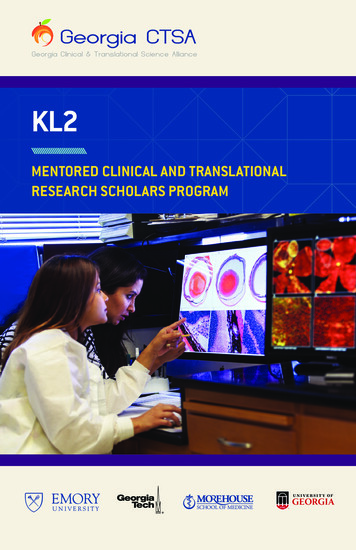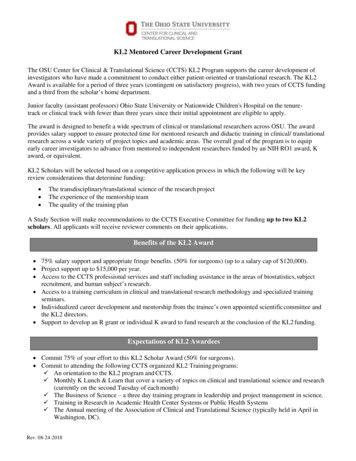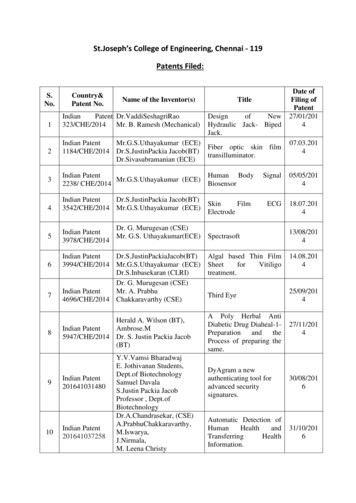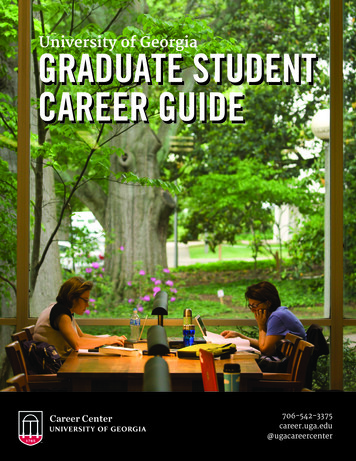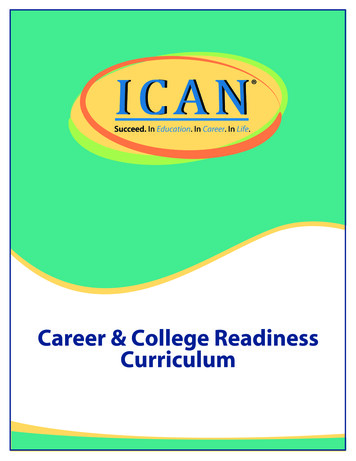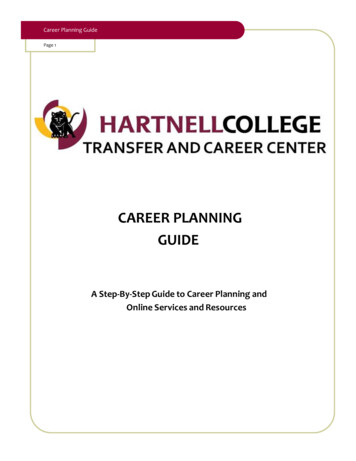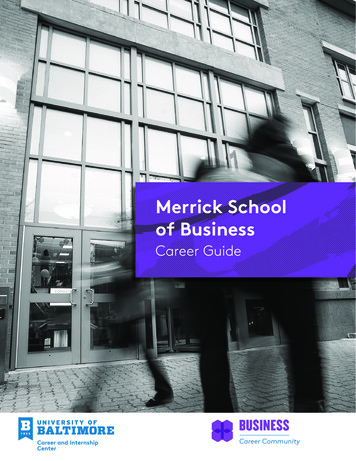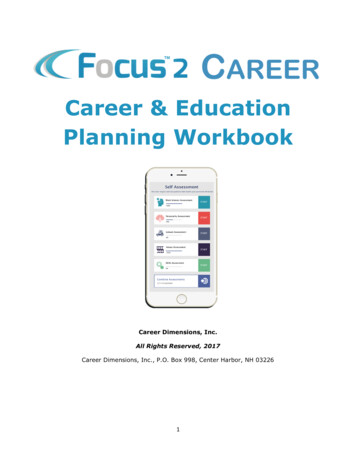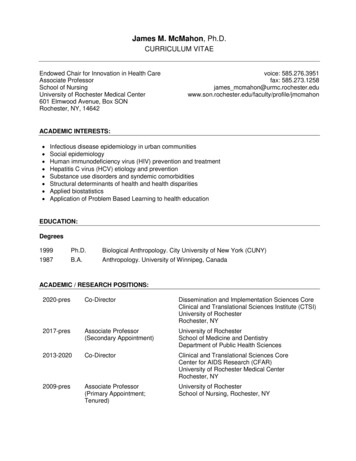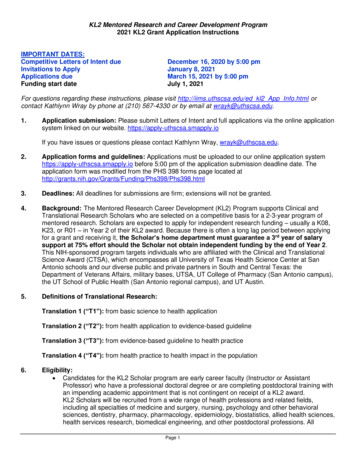
Transcription
KL2 Mentored Research and Career Development Program2021 KL2 Grant Application InstructionsIMPORTANT DATES:Competitive Letters of Intent dueInvitations to ApplyApplications dueFunding start dateDecember 16, 2020 by 5:00 pmJanuary 8, 2021March 15, 2021 by 5:00 pmJuly 1, 2021For questions regarding these instructions, please visit http://iims.uthscsa.edu/ed kl2 App Info.html orcontact Kathlynn Wray by phone at (210) 567-4330 or by email at wrayk@uthscsa.edu.1.Application submission: Please submit Letters of Intent and full applications via the online applicationsystem linked on our website. https://apply-uthscsa.smapply.ioIf you have issues or questions please contact Kathlynn Wray, wrayk@uthscsa.edu.2.Application forms and guidelines: Applications must be uploaded to our online application systemhttps://apply-uthscsa.smapply.io before 5:00 pm of the application submission deadline date. Theapplication form was modified from the PHS 398 forms page located 98.html3.Deadlines: All deadlines for submissions are firm; extensions will not be granted.4.Background: The Mentored Research Career Development (KL2) Program supports Clinical andTranslational Research Scholars who are selected on a competitive basis for a 2-3-year program ofmentored research. Scholars are expected to apply for independent research funding – usually a K08,K23, or R01 – in Year 2 of their KL2 award. Because there is often a long lag period between applyingfor a grant and receiving it, the Scholar’s home department must guarantee a 3rd year of salarysupport at 75% effort should the Scholar not obtain independent funding by the end of Year 2.This NIH-sponsored program targets individuals who are affiliated with the Clinical and TranslationalScience Award (CTSA), which encompasses all University of Texas Health Science Center at SanAntonio schools and our diverse public and private partners in South and Central Texas: theDepartment of Veterans Affairs, military bases, UTSA, UT College of Pharmacy (San Antonio campus),the UT School of Public Health (San Antonio regional campus), and UT Austin.5.Definitions of Translational Research:Translation 1 (“T1”): from basic science to health applicationTranslation 2 (“T2”): from health application to evidence-based guidelineTranslation 3 (“T3”): from evidence-based guideline to health practiceTranslation 4 (“T4”): from health practice to health impact in the population6.Eligibility: Candidates for the KL2 Scholar program are early career faculty (Instructor or AssistantProfessor) who have a professional doctoral degree or are completing postdoctoral training withan impending academic appointment that is not contingent on receipt of a KL2 award.KL2 Scholars will be recruited from a wide range of health professions and related fields,including all specialties of medicine and surgery, nursing, psychology and other behavioralsciences, dentistry, pharmacy, pharmacology, epidemiology, biostatistics, allied health sciences,health services research, biomedical engineering, and other postdoctoral professions. AllPage 1
applicants must have evidence of strong academic achievement and scholarship, as well aspersonal attributes such as a strong work ethic and integrity.Applicants must be US citizens or non-citizen nationals or must have been lawfully admitted forpermanent residence and possess an Alien Registration Receipt Card (I-151 or I-155) or someother verification of legal admission as a permanent resident. Applications will be accepted frompersons whose residence application is pending, but the residency requirement must be metprior to receiving a KL2 award. Individuals on temporary or student visas are not eligible.Applicants must be able to commit at least 75% of full-time professional effort to this CareerDevelopment Program and its related clinical/translational science research activities (50%effort may be permitted for surgeons).Applicants who are dually employed by UT Health San Antonio and the Department of VeteransAffairs may be restricted from the KL2 Scholar award, depending upon the extent ofcommitment (percent effort) to the VA. Federal salaries cannot be considered part of therequired 75% KL2 institutional commitment.Applicants must not be, or have been, a principal investigator on an R01 award or a projectleader on a subproject of a Program Project (P01), Center (P50, P60, U54) grant, or otherequivalent research grant award. Applicants may also not have another mentored researchcareer development (K-series) grant application under consideration at the time they receive aKL2. Eligible applicants may have received prior support on an Institutional or Individual NRSAgrant (F or T) or NIH small grant (R03, R21).Please note that NIH rules preclude individuals funded by the KL2 program from receivingadditional federal funds for the portion of effort not covered by the KL2 program.7.Letter of Intent: The Letter of Intent (LOI) section upload, consists of a summary no longer than 1 pageoutlining the applicant’s career development objectives, mentor(s) and mentorship plan, and researchobjectives, the letter of support from your Department Chair or Division Chief guaranteeing your 3rd yearof protected time, and an applicant biosketch in NIH tch.htm). All LOI applications must be submitted via ouronline application system https://apply-uthscsa.smapply.io . An eligibility checklist, diversityquestionnaire, and demographic information will be required as a fillable portion when you submit yourLOI online. Your LOI will be scored and successful applicants will be contacted by January 8, 2021 withan invitation to submit a full KL2 application. Thus, the LOI is required and must be received by 5:00pm on Wednesday, December 16, 2020. If you have any questions or issues, please contact KathlynnWray at wrayk@uthscsa.edu .8.Overview of Review Process: The review of full applications is performed in 2 phases: (1) scientificreview, and (2) applicant interview. The full applications will be reviewed by 2-4 scientific reviewers (1of whom may come from an outside institution having a KL2 program), who will score the applicationsfollowing KL2 program guidelines. During the final phase, applicant scores will be tabulated and ranked,and the top applicants will be interviewed by KL2 program leaders and a community member. Followinginterviews, KL2 program leaders will meet to discuss and determine awardees. Critiques from thescientific review will be provided to the applicants after awards are announced.9.Mentor Requirements: KL2 Scholars must identify a primary mentor and at least 1 other co-mentor. Ingeneral, proposed primary mentors should be currently funded (generally, at least 300,000 of grantfunding per year) and recognized as independent investigators who are actively involved in clinical ortranslational research; have a track record as a successful mentor (as exemplified in a table oftrainees); and have adequate protected time (generally at least 5% effort) for mentoring. Primarymentors will interact closely with the Scholar and provide guidance to develop a tailored careerdevelopment plan as part of an interdisciplinary mentoring team.Primary KL2 mentors are expected to have completed (or to complete in the first year of the KL2award) a mentoring workshop facilitated by the faculty development offices at UT Health San Antonio.This 8-hour program (four 2-hour sessions, held each semester) covers the following competencies:maintaining effective communication; aligning expectations; assessing understanding; addressingPage 2
equity and inclusion; fostering independence; and promoting professional development. Furthermore,KL2 applicants and their proposed mentors are required to submit with the KL2 application a writtenmentoring agreement/individual development plan specifying: (1) the applicant’s planned researchactivities (planned abstracts, papers, grant applications); (2) planned educational activities; (3) plannedprofessional/career development activities (e.g., skills development, progress towards promotion,networking, work-life balance, plans for independence from mentor); (4) support for the applicant(protected time, resources, advocacy, emotional support); (5) communication (e.g., frequency andstructure of meetings, progress reports, feedback, confidentiality); and (6) personalconduct/interpersonal relationships (e.g., plans for managing conflicts, authorship order) [see links tosample Mentorship Agreement Template and sample Individual Development Plans below].Theeffectiveness of the mentoring relationship will be evaluated during the course of the Scholar’s awardperiod.10.Scholar Requirements: Each Scholar is expected to attend KL2 SPARK peer-mentoring sessions,SOAR career development sessions, and individual meetings with KL2 program directors, all of whichare scheduled on Thursday mornings. The Scholar must also submit an individual K or R (or equivalent,such as PCORI or VA merit) application during Year 2. To ensure that all KL2 Scholars have, ordevelop, competency in key areas of translational research, UTHSCSA offers didactic courses throughour Master of Science in Clinical Investigation – Translational Science (MSCI-TS) program andCertificate in Translational Science (see http://iims.uthscsa.edu/ed msci overview.html andhttp://iims.uthscsa.edu/ed certificate in ts.html).11.Externships: A new feature for KL2 Scholars is an opportunity for externships with outsideorganizations, such as other CTSA hubs, IIMS partner institutions, pharma/biotechnology companies(e.g., Eli Lilly), and San Antonio community organizations. The goals of these externships includeobtaining “real-world” experience in clinical and translational research, team science, or both, and alsosupplementing one’s training with opportunities not available locally. Scholars are encouraged toinclude possible externship plans in their full application.12.Budget Guidelines: The award provides up to 2 years of funding, with the 2nd year of supportcontingent on adequate progress in Year 1. A 3rd year of salary must be provided with 75% protectedtime by the Scholar’s sponsoring department should the Scholar not receive independent funding bythe end of the 2-year KL2 award period. Scholars may request 75% of their 12-month salary up to amaximum of 112,500 (in other words, Scholars whose institutional base salary is less than 150,000/year will receive 75% of their institutional base salary plus fringe benefits from the KL2 award;Scholars whose institutional base salary exceeds 150,000/year will receive 112,500 plus fringebenefits from the KL2 award; Scholars whose institutional base salary is less than 150,000/year willreceive 75% of their institutional base salary) plus fringe benefits on the awarded salary . The Scholar’sdepartment may supplement the NIH salary contribution up to a level that is consistent with theinstitution's salary scale from non-federal sources; however, supplementation may not come fromfederal funds unless specifically authorized by the federal program from which such funds are derived.Departmental supplementation of salary must not require extra duties or responsibilities that wouldinterfere with the purpose of the Program.In addition to salary and fringe, up to 25,000 annually is awarded for research and careerdevelopment support, which may include the following expenses: (1) tuition and fees related to careerdevelopment, e.g., didactic courses in the MSCI-TS or the Certificate in Translational Scienceprograms; (2) research expenses, such as supplies, equipment, and technical personnel; (3) travel toexternships, research meetings, workshops, or training (KL2 applicants must allow 1,500 for travel tothe Translational Science annual meeting in Washington each spring); and (4) other projectinfrastructure including relevant data sets. Salaries for mentors, secretarial and administrative staff, etc.are not allowed as part of the KL2 Program.Biostatistical and REDCap support will be provided at no charge to KL2 Scholars through theDepartment of Epidemiology and Biostatistics during the Scholar’s 2 years of KL2 support.Page 3
13.Letter of Support: Applications must include letters of support from the applicant’s primary mentor.The primary mentor’s letter should indicate whether he/she is willing to participate in the mentor trainingworkshops.14.Application forms (modified from SF424) may be downloaded from UTHSCSA IIMS KL2 Applicationsforms page http://iims.uthscsa.edu/ed KL2 App Forms.html. Applications must be submitted as singlespaced text with a minimum of one-half inch margins and 11-point Arial font. The career developmentplan and research plan are limited to a total of 12 pages, combined. ***Note: When uploading inthe Survey Monkey Apply application system, the 1-page Specific Aims page will be uploadedtogether with (right before) the Research Plan – totaling 13 pages maximum.15.Composition of Research Proposal: Research proposals should include the following. For additionalguidance regarding the Specific Aims, Career Development Plan, Research Strategy, and othersections, applicants may refer to the “Career Development Instructions for NIH and Other PHSAgencies” document ation-guide/forms-e/careerforms-e.pdf)Required Elements andPage LimitsInstructions/FormatFace PagePart of LOIThe Project Summary must contain a summary of the proposed activity suitable fordissemination to the public. It should be a self-contained description of the project andshould include a statement of objectives and methods to be employed. It should beinformative to other persons working in the same or related fields and insofar as possibleunderstandable to a scientifically or technically literate lay reader. This Summary mustnot include any proprietary/confidential information.ProjectSummary/AbstractThe Project Summary is meant to serve as a succinct and accurate description of theproposed work when separated from the application. State the application’s broad, longterm objectives and specific aims, making reference to the health relatedness andtranslational nature of the project. Describe concisely the research design and methodsfor achieving the stated goals. This section should be informative to other personsworking in the same or related fields and insofar as possible understandable to ascientifically or technically literate reader. Avoid describing past accomplishments andthe use of the first person in this section. This section must be no longer than 30 linesof text, and follow the required font and margin specifications.Detailed budgetWithin the guidelines of this RFA Provide a budget for the first and second year budgetperiods using the forms provided.Budget justificationProvide a justification for the first and second year budget periods using the formsprovided.Biosketches(maximum 5 pages each)Provide a biographical sketch for the candidate and Mentor (co-Mentor(s) and any othersenior/key personnel if desired), using the NIH format, which can be found .htm.Other supportProvide other support information for the candidate and Mentor, using the form provided.Complete using blank pages.KL2 Career DevelopmentPlan(12 pages, combined withResearch plan)1. Candidate’s BackgroundDescribe your past scientific history, indicating how the award fits into past and futureresearch career development. If there are consistent themes or issues that have guidedprevious work, these should be made clear; if your work has changed direction, thereasons for the change should be indicated. Any additional information not described inthe Biographical Sketch Format Page, such as research and/or clinical trainingexperience, may be included in this section.Page 4
Required Elements andPage LimitsInstructions/FormatSuggested points to include: Describe the candidate's commitment to an academic career in Clinical /Translational Research. Include a description of all of the candidate'sprofessional responsibilities in the grantee institution and elsewhere andshow their relation to the proposed activities on the career award. Present evidence of the candidate's ability to interact and collaborate withother scientists. Describe prior training and how it relates to the objectives and long-termcareer plans of the candidate. Describe the candidate's research efforts to this point in his/her researchcareer, including any publications, prior research interests and experience. Provide evidence of the candidate's potential to develop into an independentinvestigator. Include a statement that the candidate will commit at least 9 person-months(75% of full-time professional effort) to the KL2 program and related careerdevelopment activities. The mentor or department chair must agree andprovide a statement in the application documenting that this percent of thecandidate’s time will be protected.2. Career Goals and ObjectivesDescribe your short-term and long-term career goals and objectives, and how the careerdevelopment award is envisioned to enable you to develop and/or expand your researchcareer. It is important to justify the need for the award. You are encouraged to include atimeline, including plans to apply for subsequent grant support (i.e., to become anindependent investigator).3. Candidate’s Plan for Career Development/ Training Activities During AwardPeriod, including any planned externships Describe the new or enhanced research skills and knowledge you will acquire asa result of the proposed award. If you have considerable research experience inthe same areas as the proposed research, reviewers may determine that theapplication lacks potential to enhance your research career. Describe any structured activities that are part of the developmental plan, suchas coursework, workshops or externships that will help you learn new techniquesor develop needed professional skills. The didactic (if any) and the researchaspects of the plan must be designed to develop the necessary knowledgeand research skills in scientific areas relevant to the candidate's careergoals. The candidate must demonstrate he/she has received training or willparticipate in courses such as: data management, epidemiology, studydesign (including statistics), hypothesis development, drug development,etc., as well as the legal and ethical issues associated with research onhuman subjects. If coursework is included, provide course numbers anddescriptive titles. Briefly discuss each of the activities, other than research, inwhich you expect to participate. Describe the professional responsibilities/activities including othe r researchprojects) beyond the minimum required 75% effort commitment to the KL2award. Explain how these responsibilities/activities will help ensure careerprogression to achieve independence as an investigator conducting patient oriented research.4. Mentor statementThe Lead Mentor and Co-Mentor(s) statement may include the following:Page 5
Required Elements andPage LimitsSpecific Aims (1 page)Instructions/Format The plan for the candidate's training and research career development. Thisdescription must include not only research, but also other developmentalactivities, such as seminars, scientific meetings, training in the responsibleconduct of research, and presentations. It should discuss expectations forpublications over the entire period of the proposed project and define whataspects of the proposed research project the candidate will be allowed to takewith him/her to start their own research program. Any additional sources of anticipated support for the candidate’s research projectfor each year of the award period. The nature and extent of supervision and mentoring of the candidate, andcommitment to the candidate's development that will occur during the awardperiod. The candidate's anticipated teaching load for the period of the award, ifapplicable (number and types of courses or seminars), clinical responsibilities,committee and administrative assignments, and the portion of time available forresearch. A plan for transitioning the candidate from the mentored stage of his/her careerto an NIH K award or an R-level award by the end of the project period of theaward. The mentor should describe previous experience as a mentor, includingtype of mentoring (e.g., graduate students, career development awardees,postdoctoral students), number of persons mentored, and career outcomes. His/her willingness to participate in the mentor training gComplete using blank pages.State precisely the goals of the proposed research and summarize the expectedoutcome(s) including the impact that the results of the proposed research will exert onthe research field(s) involved.List succinctly the specific objectives of the research proposed, e.g., to test a statedhypothesis, create a novel design, solve a specific problem, challenge an existingparadigm or clinical practice, address a critical barrier to progress in the field, or developnew technology.Complete using blank pages.Organize the Research Strategy in the specified order and using the instructionsprovided below. Start each section with the appropriate section heading – Significance,Innovation, Approach. Cite published experimental details in the Research Strategysection and provide the full reference in the Bibliography and References Cited section.(a) SignificanceResearch Strategy(12 pages, combined withcareer development plan) Explain the importance of the problem or critical barrier to progress in the fieldthat the proposed project addresses. Explain how the proposed project will improve scientific knowledge, technicalcapability, and/or clinical practice in one or more broad fields. Describe how the concepts, methods, technologies, treatments, services, orpreventative interventions that drive this field will be changed if the proposedaims are achieved.(b) Innovation Explain how the application challenges current research or clinical practiceparadigms. Describe any novel theoretical concepts, approaches or methodologies,instrumentation or interventions to be developed or used, and any advantagePage 6
Required Elements andPage LimitsInstructions/Formatover existing methodologies, instrumentation, or interventions.(c) Approach Describe the overall strategy, methodology, and analyses to be used toaccomplish the specific aims of the project. Unless addressed separately in Item21 (Resource Sharing Plan), include how the data will be collected, analyzed,and interpreted as well as any resource sharing plans as appropriate. Discuss potential problems, alternative strategies, and benchmarks for successanticipated to achieve the aims. If the project is in the early stages of development, describe any strategy toestablish feasibility, and address the management of any high-risk aspects of theproposed work. Point out any procedures, situations, or materials that may be hazardous topersonnel and precautions to be exercised.Complete using blank pages.Training in theResponsible Conduct ofResearch(1 page) Applications must include a plan to obtain instruction in the responsibleconduct of research. This section should document prior instruction in responsible conduct ofresearch during the applicant’s current career stage (including the date of lastoccurrence) and propose plans to receive instruction in responsible conductof research. The plan may include career stage-appropriate, individualized instruction orindependent scholarly activities that will enhance the applicant’sunderstanding of ethical issues related to their specific research activities andthe societal impact of that research. Institutional Environment(1 page)Statement of how theresearch is translational(no page limit but please besuccinct)Protection of HumanSubjects(no page limit but please besuccinct)Vertebrate Animals(no page limit but please besuccinct)The role of the sponsor/mentor in responsible conduct of research instructionmust be described. (see example on websitehttp://iims.uthscsa.edu/ed KL2 App Forms.html)Complete using blank pages. Specify specific resources that support the proposed research.Complete using blank pages.Complete using blank pages.This section is required for applicants whose project involves human subjects. Do notuse the protection of human subjects section to circumvent the page limits of theResearch Strategy.Complete using blank pages.This section is required for applicants whose project involves vertebrate animals.If so, you must address the following 5 key points. In addition, when research involvingvertebrate animals will take place at collaborating site(s) or other performance site(s)provide this information before discussing the 5 points. Although no specific pagelimitation applies to this section of the application, be succinct.1.Provide a detailed description of the proposed use of the animals in the workoutlined in the Research Strategy section. Identify the species, strains, ages, sex,and numbers of animals to be used in the proposed work.2.Justify the use of animals, the choice of species, and the numbers to be used. Ifanimals are in short supply, costly, or to be used in large numbers, provide anadditional rationale for their selection and numbers.Page 7
Required Elements andPage LimitsInstructions/Format3.Provide information on the veterinary care of the animals involved.4.Describe the procedures for ensuring that discomfort, distress, pain, and injury willbe limited to that which is unavoidable in the conduct of scientifically soundresearch. Describe the use of analgesic, anesthetic, and tranquilizing drugs and/orcomfortable restraining devices, where appropriate, to minimize discomfort,distress, pain, and injury.5.Describe any method of euthanasia to be used and the reasons for its selection.State whether this method is consistent with the recommendations of the AmericanVeterinary Medical Association (AVMA) Guidelines on Euthanasia. If not, include ascientific justification for not following the recommendations.If the involvement of animals is indefinite, provide an explanation and indicate when it isanticipated that animals will be used. If an award is made, prior to the involvement ofanimals the grantee must submit to the NIH awarding office detailed information asrequired in points 1-5 above and verification of IACUC approval. If the grantee does nothave an Animal Welfare Assurance then an appropriate Assurance will be required (seePart III Section 2.2 Vertebrate Animals for more information).Do not use the vertebrate animal section to circumvent the page limits of the researchstrategy.Select Agent Research(no specific page limitationapplies, but please besuccinct)Bibliography andReferences Cited(no page limitation applies)Diversity QuestionnaireChecklist (required by NIH)Letter of Support byComplete using blank pages.This section is required for applicants whose project involves select agents.Select Agents are hazardous biological agents and toxins that have been identified byDHHS or USDA as having the potential to pose a severe threat to public health andsafety, to animal and plant health, or to animal and plant products. CDC maintains a listof these agents. See http://www.cdc.gov/od/sap/docs/salist.pdf.If any of the activities proposed in your application involve the use of Select Agents atany time during the proposed project period, either at the applicant organization or at anyother performance site, address the following 3 points for each site at which Select Agentresearch will take place. Although no specific page limitation applies to this section, besuccinct.1. Identify the Select Agent(s) to be used in the proposed research.2. Provide the registration status of all entities* where Select Agent(s) will be used.o If the performance site(s) is a foreign institution, provide the name(s) of thecountry or countries where Select Agent research will be performed.*An “entity” is defined in 42 CFR 73.1 as “any government agency (Federal,State, or local), academic institution, corporation, company, partnership, society,association, firm, sole proprietorship, or other legal entity.”3. Provide a description of all facilities where the Select Agent(s) will be used.o Describe the procedures that will be used to monitor possession, use andtransfer of the Select Agent(s).o Describe plans for appropriate biosafety, bio-containment, and security ofthe Select Agent(s).o Describe the bio-containment resources available at all performance sites.Complete using blank pages.Provide a bibliography of any references cited in the Project Narrative. Each referencemust include the names of all authors (in the same sequence in which they appear in thepublication), the article and journal title, book title, volume number, page numbers, andyear of publication. Include only bibliographic citations. Applicants should be especiallycareful to follow scholarly practices in providing citations for source materials relied uponwhen preparing any section of the application.Part of LOIInstructions: The letter should comment on the applicant’s qualifications for a futurePage 8
Required Elements andPage LimitsInstructions/FormatDepartment / DivisionChaircareer as an independent translational research scientist. Please indicate the resourcesthat you will provide to support the candidate’s research. Be specific as to amount ofspace, number and kind of staff, clinical and lab resources, and dollars you will makeavailable to the scholar.Letters of support fromcollaborators orconsultantsInclude if appropriate.Mentoring agreementSample available at https://iims.uthscsa.edu/ed KL2 App Forms.htmlIndividual developmentplanSample available at https://iims.uthscsa.edu/ed KL2 App Forms.htmlFor questions, please contact Kathlynn Wray
Department of Veterans Affairs, military bases, UTSA, UT College of Pharmacy (San Antonio campus), the UT School of Public Health (San Antonio regional campus), and UT Austin. 5. Definitions of Translational Research: Translation 1 ("T1"): from basic science to health application
